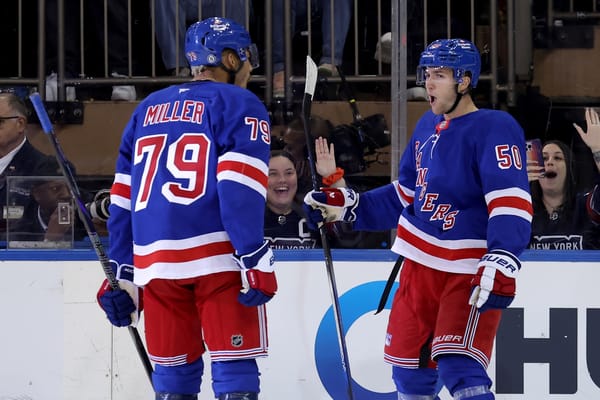Kevin Shattenkirk Could Be Old Man Out on ‘New Youth Rangers’ Blue Line
From Trouba to Fox, how the new-look Blueshirts defense could force New York’s hand ahead of the Draft
Since acquiring Jacob Trouba from the Winnipeg Jets this week, two key factors have since emerged for the New York Rangers that could come to a head during the opening night of the NHL’s Entry Draft this Friday night, if not sooner:
The first is that Trouba — who is likely to become a cornerstone of the new-look Blueshirts — has fundamentally changed the landscape of New York’s defense. The second — a byproduct of that change — is that Kevin Shattenkirk’s tenure on Broadway is likely on the clock.
Much has been said of Trouba and his long-term future on Broadway. Banter’s own Tom Urtz Jr. wrote extensively on the matter, as did Joe Fortunato. But it’s Shattenkirk who is of particular interest here given the predicament the acquisition of Trouba has put him in.
All about the Jacob Trouba trade:
— BlueshirtBanter (@BlueshirtBanter) June 18, 2019
The trade announcement: https://t.co/EQiZOojkLP
The #NYR’s position to benefit: https://t.co/3kK4LIdot7
The statement made by Jeff Gorton: https://t.co/vs6MYq8onY
Reactions from last night on Bantering the Blueshirts: https://t.co/yads8hPizu pic.twitter.com/E27F0VPSyt
Shattenkirk, 30, signed a team-friendly deal to play for the club he grew up cheering for. But that good will has gone largely unrewarded as he’s had just about everything go wrong that could go wrong since the ink dried on his contract. Two years into that four-year ticket, he’s now on the wrong side of 30. He’s also entering the third year of a years-long rebuild he surely didn’t sign up for with two surgically repaired knees that have further limited his effectiveness on the ice in an NHL atmosphere that puts a premium on not just talent, but speed.
Worse yet, as a player who has produced nearly half of his NHL points on the man advantage, he could even be starting this season not anchoring the top unit, as he’s designed to.
According to Larry Brooks of the New York Post, the newly-acquired Trouba is slated to step onto the first unit in direct replacement of Shattenkirk, who may not even find home on the second should Adam Fox make the team, as expected.
Bumped from his wheelhouse, this wouldn’t be unfamiliar territory for Shattenkirk, who lost his first-unit quarterback job to Neal Pionk for a stretch last season, too — a scenario that understandably caused his production to plummet.
Moreover, again according to Brooks, there’s ostensibly no interest in the veteran puck-mover, even with salary retention on the table — an apparent fact that’s just as jaw-dropping as the suggestion that the Rangers could also seriously consider buying him out in the event they can’t find a trade partner.
“Kevin Shattenkirk, with two years remaining at an annual $6.65 million cap hit, is also a buyout possibility,” said Brooks back on June 11.
With approximately $19 million in cap space to work with to sign free agents — both restricted and unrestricted this July — it’s fair to question the merit of a buyout given the fact that one performed this summer would result in four years of dead cap on the Rangers’ tab. But it’s also undeniable that the addition of Trouba has further complicated the blue line log jam the Blueshirts were already pressured by even before he arrived.
Despite Neal Pionk heading to Winnipeg as part of the Trouba trade, the right side of the Rangers’ defense is still untenably crowded. Trouba, Fox, and Tony DeAngelo are expected to slot in on that front, perhaps in that exact order, leaving no room at the inn for the $6.5 million dollar spare in Shattenkirk.
Something has to give.
The fact of the matter is that the math, though still in the Rangers favor for now, is heavily not in favor for number 22. MSG’s own John Gianonne, in fact, pegs the veteran defender in the bottom two of the pecking order heading into next season:
.@jaygeemsg breaks down potential @NYRangers D pairings for next season.
— MSG Networks (@MSGNetworks) June 19, 2019
Do you agree or disagree? 👇#MSG150 |#RookieWeek pic.twitter.com/COlSun29Df
No matter your opinion on the quality of play of Shattenkirk, there’s no denying this isn’t a great look for he or the Rangers. In fact, the last time the Blueshirts were looking down the barrel of a $6.5 million dollar spare, they sidestepped the issue by stashing him in the AHL before unceremoniously buying him out as part of the NHL’s compliance program.
Now, make no mistake — Shattenkirk is no Wade Redden. But the parallels here, if only contract-wise, are no less unsettling.
Despite all of this, Shattenkirk is still a valuable NHL player, albeit one with cap- and injury-fueled issues in New York. When healthy — granted, a significant caveat — he is still a positive factor in moving the puck up the ice, which is still the primary function of a successful defender in today’s NHL. All of which makes the suggestion that not a single NHL team — even those tripping over themselves to acquire inferior players like Nikita Zaitsev, Zach Bogosian, or Rasmus Ristolainen — have any interest at all perplexing.
Source : #Canucks seem to be talking with Buffalo about a defenseman, not sure if its Rasmus Ristolainen or Zach Bogosian.
— Rick Dhaliwal (@DhaliwalSports) June 18, 2019
Are we really to believe that the Tampa Bay Lightning — who were rumored to be courting Erik Karlsson despite their imposing cap crunch — would have no interest in Shattenkirk as a consolation prize? The same Lightning who were prepared to offer Shattenkirk a seven-year, $42 million extension upon acquiring him in 2017?
With Tampa, the cap issue isn’t an insignificant factor, but there’s little stopping New York from getting creative to make it work should interest pique.
What about the Toronto Maple Leafs, who are probably going to continue to hunt for a right-side defender? Zaitsev has requested a trade, and both Ron Hainsey and Jake Gardiner are free agents. Gardiner plays the left, but the cumulative loss of all three would put a serious strain on the ability of their blue line to move the puck next season.
Like the Lightning, the Leafs are up against the cap in a bad way, with major decisions to make on Mitch Marner & co. up front. Shattenkirk at half the price could be workable, especially since they’ll find few right-handed puck movers with his skill for less.
Frankly, at a much more manageable cap hit of $3.325 million for the next two years, there simply cannot be a single NHL team uninterested in a pissed off and motivated Shattenkirk.
Awarded a modified no-trade clause in which he submits a ten-team no-trade list each season through to 2020, Shattenkirk has some say in where he might land, but that still leaves the Rangers two-thirds of the league with which to negotiate an exit strategy.
For the “keep him and build up his value” crowd, ask yourself this: how could that reasonably be accomplished if this time around the power play displacement were made permanent? It’s going to be awfully hard to pick up points with little to no power special teams time and third-pairing duties which will limit, if not eliminate entirely, whatever trade market one would hope to garner for him down the line.
Despite Brooks’ report and Shattenkirk’s mild trade protection, it seems unlikely that a trade opportunity can’t still manifest for the veteran player, perhaps prior to, or at the NHL Draft this Friday. Especially if Jeff Gorton is willing to retain up to half of Shattenkirk’s contract to sweeten the idea for inquiring teams.
In the event one doesn’t, though, there’s always the chance that the Rangers simply kick the can down the road (for now) while allowing a few of their young defenders to ripen — if not over-ripen — in the AHL. That could even include the aforementioned Fox.
The Wolf Pack are every bit as in on this rebuild, too, and big minutes are sure to be there for whoever fails to make the NHL cut. If only for a short while as Gorton continues to sort personnel matters with the big club.
But one way or another, the clock is ticking rather loudly on Shattenkirk, who could very well be calling another city home before the start of the weekend.
With a lot more invested in the Rangers’ more promising right-siders, Shattenkirk is unfortunately the odd — old? — man out both today and tomorrow. The sooner he and the Rangers come to grips with this, the sooner they can strike a deal, and the sooner their rebuild — the one he never signed up for in the first place — can truly begin to take logical shape.




